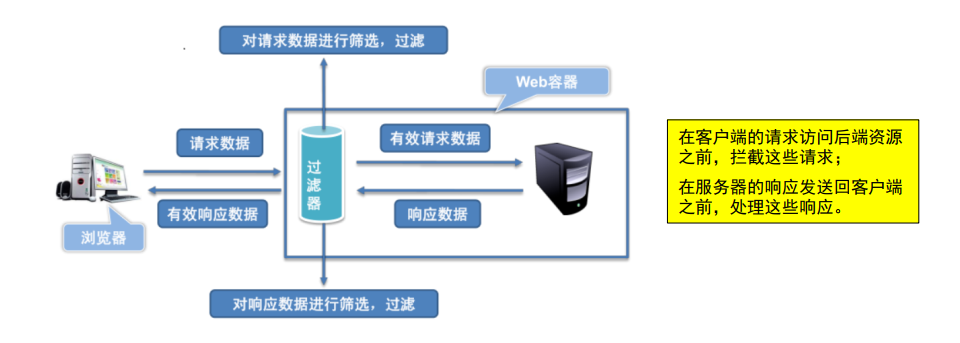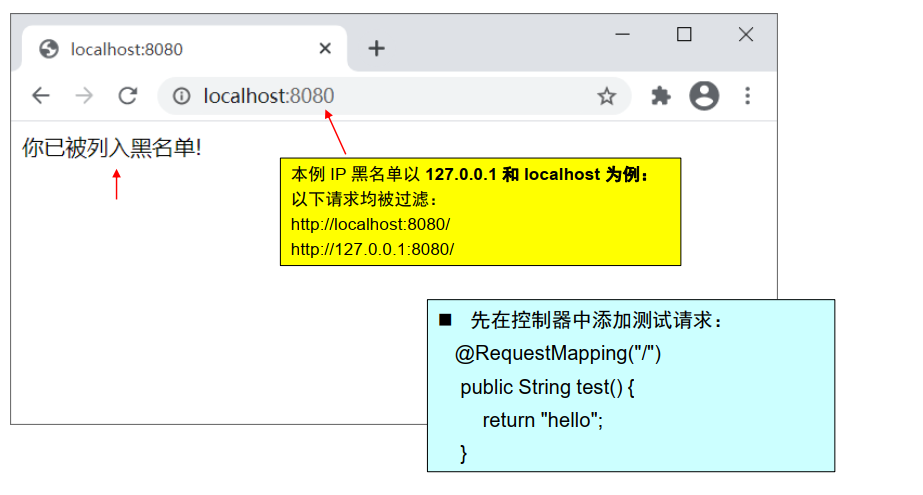filter
◼ Filter s can dynamically intercept requests and responses.
◼ Application scenario: filter sensitive words, prevent SQL injection, set character encoding, and perform URL level
Other permissions, access control, compression response information, etc.

Filter programming step 1: create a filter class
◼ Write a Java class to implement the Filter interface (mainly the doFilter() method);
◼ The filter class is annotated with the annotation @ WebFilter, and the filter url is configured.

Three method descriptions of Filter interface:
The Filter starts with the start of the web application, is initialized only once, and is destroyed with the stop of the web application.
- Load the instance of the filter when starting the server, and call the init() method to initialize the instance;
- Each request only calls the doFilter() method for processing;
- When stopping the server, call the destroy() method to destroy the instance
Filter class basic code framework
Filter class basic code framework
@WebFilter("/*") // The current configuration intercepts all requests
public class MyFilter implements Filter {
@Override
public void doFilter(ServletRequest request, ServletResponse response, FilterChain chain)throws IOException, ServletException {
if(Certain condition){
//Interception processing
}
else{
chain.doFilter(request, response); // Release
}
}
}
Filter programming step 2: load filter
◼ Add the @ ServletComponentScan annotation on the Spring Boot startup class.

Filter programming example: IP blacklist

import javax.servlet.*;
import javax.servlet.annotation.WebFilter;
import java.io.IOException;
import java.util.ArrayList;
import java.util.List;
@WebFilter("/*")
public class MyFilter implements Filter {
//Blacklist simple simulation
private List<String> IPList=new ArrayList<>();
@Override
public void init(FilterConfig filterConfig) throws ServletException { //Filter initialization
IPList.add("127.0.0.1"); // Local address
IPList.add("0:0:0:0:0:0:0:1"); // IPv6 native address
}
@Override
public void doFilter(ServletRequest servletRequest, ServletResponse servletResponse, FilterChain filterChain) throws
IOException, ServletException {
//Blacklist filtering
String ip = servletRequest.getRemoteAddr(); // Get client ip address
System.out.println(ip); //Check it on the console
if( IPList.contains(ip) ){
servletResponse.setContentType("text/html;charset=utf-8"); //Set the character set of the response (avoid Chinese garbled code)
servletResponse.getWriter().println("You have been blacklisted!");
}
else{
filterChain.doFilter(servletRequest,servletResponse); //Release
}
}
}
Interceptor
◼ Interceptor is mainly used to intercept user requests and process them accordingly.
◼ The reflection mechanism based on Java belongs to the application of aspect oriented programming (AOP).
◼ Application scenario: verify user login status, authority verification, record system log, general processing, etc.
Interceptor programming step 1: create interceptor class
Write a Java class to implement the HandlerInterceptor interface (mainly implementing the preHandle() method)

Three method descriptions of HandlerInterceptor interface:
preHandle: called before the service processor processes the request;
postHandle: executed after the business processor processes the request and before generating the view;
After completion: called after the dispatcher servlet has completely processed the request (after rendering the page).

Interceptor class basic code framework
public class MyInterceptor implements HandlerInterceptor {
//Called before processing the request. Permission verification and security control can be carried out;
boolean preHandle(HttpServletRequest request, HttpServletResponse response, Object handler)
throws Exception;
// Set conditions for intercepted services
// return true; Release (release when conditions are met and continue business processing)
// return false; Intercept (jump to other processing when conditions are not met)
}
Interceptor programming step 2: create interceptor configuration class
◼ Write a Java class to implement the WebMvcConfigurer interface (mainly to implement addInterceptors())
Method)
◼ This class is marked with the annotation @ Configuration (indicating that it is a Configuration class)
Interceptor configuration class basic code framework
@Configuration // Indicates that it is a configuration class. Don't drop it!
public class MyWebConfig implements WebMvcConfigurer {
@Override
public void addInterceptors(InterceptorRegistry registry) { //Load interceptor
registry.addInterceptor( new MyInterceptor () ) //Load custom interceptors
.addPathPatterns("/**") //The path to intercept requests / * * indicates all requests
.excludePathPatterns("/","/css/*","/images/*","/js/*"); //Non intercepted requests, such as home page, static resources, etc
}
}